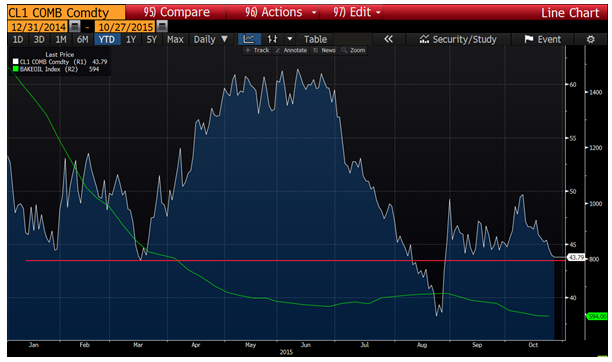Asian markets are clearly unwilling to rally past the recent highs they set last Friday ahead of the Fed and Bank of Japan (BoJ) meetings. Volumes were down dramatically across the region. The Nikkei 225 volumes were 20.6% below their 30-day average, while the Hang Seng and the S&P/ASX 200 were down 31.2% and 17.1% respectively. Traders are largely sitting on the sidelines at the moment.
For markets to rally further we would probably need to see the Fed definitively push their first rate hike out into 2016 in the dot plots and the BoJ step up its monetary stimulus. The former is quite likely, while the latter is a close call. While most markets would probably take the Fed rate hike delay as a positive irrespective of the BoJ decision, Japanese markets could see a noticeable drop if BoJ refuses to act and the USD/JPY could push to 118 or even lower.
Commodities have been continuing to weaken during Asian trade. Dalian iron ore futures were down 1.5% at one point, although have pared that back to 1% since. WTI oil has fallen a further 1.6% in Asian trade.
The WTI oil price has declined 13.4% since 9 October, reaching its lowest level since 10 September. The oil price is now breaking key technical resistance around the US$43.50 level and the question emerging is whether oil is going to pivot back up to US$50 or plummet to re-test its August lows below US$40.

White active WTI contract (daily price), green Baker Hughes (N:BHI) crude oil drill rig count (weekly)
WTI lost a further 1.7% yesterday to drop back below US$40. This seems to partly be a reaction to the decline in the Baker Hughes drill rig count slowing, as the weekly drill rig count declined from 595 to 594. There does seem to be an interesting correlation between the drill rig count and WTI. Since March, strong declines in the drill rig count have been bullish for the oil price, while the big sell offs in July and August also corresponded to a plateauing and slight uptick in the drill rig count. Undoubtedly, Friday’s drill rig count looks set to be a major mover in the oil price. If we see a pickup in the rig count decline, that is likely to be bullish and help break the current downtrend, whereas if it is flat or increasing, prices could be pushed in the US$40 direction.
We have entered the normal refinery maintenance season, which has helped push crude supplies up further with less refineries running to handle the output. This has pushed oil contango, the difference between the December and January WTI contracts, to its widest level in five months.
The big question is whether OPEC and other oil producers can continue to handle prices at these levels. There have been calls from Russia and Venezuela in recent weeks for OPEC and non-OPEC producers to meet and agree on cutting production. This week Algeria also backed Venezuela’s call for the meeting. Despite the marked drop in US shale oil production, global oil supplies have remained stubbornly high. But now that OPEC nations have been steadily regaining global market share, they may be more inclined to start to trim back their production. The big unknown is how much pain they need to inflict on US shale oil producers before they cut back, but moves on this front could certainly see some upside in the oil price.
ASX
The ASX opened fairly flat on the back of poor US leads. Resources and oil both fared poorly overnight and this continued into Asian trade seeing the materials and energy sectors perform the worst on the index today. Despite the poor performance seen across the Asian region, the ASX has managed to grimly cling on around the 5350 level.
The healthcare sector outperformed all the others by a long shot. Cochlear Ltd (AX:COH) (+1.4%), CSL Ltd (AX:CSL) (+1.7%), and Sonic Healthcare Ltd (AX:SHL) (1.7%) saw the best performances in the sector.
With no energy M&A to light up the sector today and new lows hit in oil prices, the energy sector fell 2.2%. Beach Energy Ltd (AX:BPT) reported relatively unchanged production from the previous quarter, which with the current market sentiment was taken as a negative and the stock dropped 4.4%. Worley Parsons Ltd (OTC:WYGPY) and AWE Ltd (AX:AWE) also saw major declines, losing 5.5% and 6.1%, respectively.
The materials sector also saw a lot of weakness, losing 1.3%. The drop in the iron ore price was being taken out on Fortescue, as it lost 7.4%. While gold miner Northern Star Resources Ltd (AX:NST) seemed to react badly as it was cut to hold by a number of research houses, losing 9.3%.
